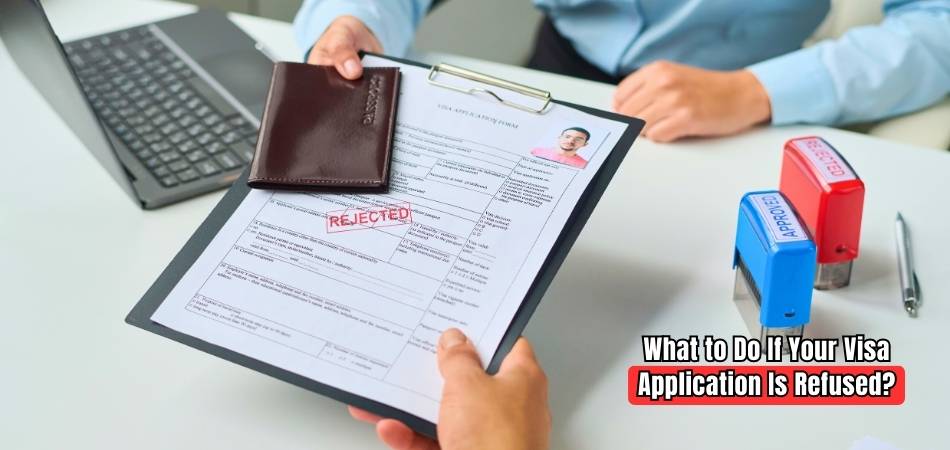A visa is your gateway to opportunities abroad, but what happens if your application is denied? Facing rejection can be stressful, but being aware of what to do if your visa application is refused is crucial to turning things around.
Fortunately, you have options: you can reapply, provide additional supporting documents, appeal the decision if you believe an error occurred, or learn from the reasons outlined in the refusal letter to strengthen future applications. Exploring ineligibility waivers can also help in certain cases.
You will learn about each step of the process in this blog so that you are better prepared for success. Find out how to deal with visa refusals with confidence by reading on.
Is It Possible to Freely Travel Between Countries?
Yes, but it depends on specific circumstances. Traveling freely between countries often requires agreements, such as visa-free arrangements or special treaties. For instance, citizens of certain nations can visit others without needing a visa for short stays.
However, restrictions exist for many travelers. Countries may require visas, permits, or meet eligibility conditions before granting entry. Factors like nationality, purpose of visit, and financial proof often determine ease of travel.
Some areas, like the European Union, allow border-free travel within member states. Others, however, enforce strict immigration controls, even for transit travelers. Always check the requirements for each destination to ensure smooth, hassle-free journeys.
The Visa Application Process: What Do You Need?
Applying for a visa involves specific steps and essential documents. Every country has its unique requirements, so preparation is key. Below are the main things you need to ensure a smooth application process:
- Valid Passport: Ensure your passport is valid for at least six months beyond your travel date. Check for blank pages for visa stamps.
- Completed Application Form: Fill out the application form accurately and truthfully. Any errors or omissions may lead to delays or rejections.
- Passport-Sized Photos: Provide recent passport-sized photos meeting the specifications of your destination country. Incorrect photo formats can cause application issues.
- Proof of Travel Plans: Submit flight bookings or itinerary to show your travel dates and plans. Confirmed bookings are often preferred for visa approvals.
- Proof of Financial Means: Demonstrate your financial capability to cover expenses during your trip. This can include bank statements, sponsorship letters, or pay slips.
- Supporting Documents: Depending on visa type, provide relevant documents like invitation letters, employment proof, or school enrollment letters. Work with these to match your purpose.
- Visa Fee Payment Receipt: Pay the required visa fee and attach the receipt. Payment proof is essential for processing your application efficiently.
- Health Insurance or Medical Requirements: Some visas require health insurance or proof of vaccinations. Ensure these meet the requirements of your intended destination.
Can a Visa Application be Refused?
Yes, a visa application can indeed be refused. The reasons for rejection are varied and depend on the destination country’s specific requirements. So, being aware of the common causes for Canada visa rejection can help applicants avoid similar mistakes.
Each country has its own rules for issuing visas, and not meeting these criteria can result in a refusal. For instance, providing incomplete application forms or lacking sufficient funds may lead to denial. Applicants should ensure all documentation is complete and accurately reflects their situation.
Travelers must align their applications with the visa type they are applying for. Mismatches between the stated purpose of the visit and the evidence provided can cause issues. Always double-check to ensure that your application is consistent and truthful.
What to Do If Your Visa Application Is Refused?
Having your visa application refused can feel overwhelming, but it doesn’t mean the end of your journey. Figuring out why it happened and knowing the steps to take can improve your chances next time. Here’s what you should do if your visa application is refused.
Know the Reason for Refusal
Carefully read the refusal letter to identify the reasons for the rejection. This document explains specific areas where you fell short. Knowing these reasons helps you address issues before reapplying. Future applications should avoid repeating mistakes.
Decide Whether to Reapply or Wait
You can reapply immediately or wait until your circumstances change significantly. Evaluate whether the original issues can be fixed right away. If your situation hasn’t changed, waiting might save you time and effort. Ensure you address all refusal points before applying again.
Submit Additional Supporting Documents
Sometimes, adding missing or stronger documents can improve your chances. Include financial proof, travel plans, or any required certificates. Ensure all documents are recent and accurately meet the visa requirements. Strong supporting evidence strengthens your case for approval.
Consider Filing an Appeal
Many countries allow visa refusal appeals through administrative tribunals. Review the appeal process and timelines specific to the country. Appeals require evidence showing why the decision was incorrect. Seek legal advice if unsure about the appeal procedure.
Learn From Your Mistakes
Use the rejection as an opportunity to improve your application. Avoid the errors mentioned in the refusal letter. Double-check every form and document before reapplying. Take time to prepare a stronger application based on learned insights.
Seek Professional Guidance
If unsure, consult an immigration consultant or legal expert for advice. Professionals can guide you through reapplication or appeal processes. Their expertise ensures you meet all the requirements for your next application. This step increases the likelihood of approval.
How to Request a Reconsideration of Your Visa Application?
Receiving a visa refusal can feel discouraging, but it doesn’t mean you’re out of options. Requesting a reconsideration is one way to challenge the decision. Follow this step-by-step guide to ensure your request is strong and professional.
Step 1: Review the Refusal Letter Carefully
Begin by thoroughly reading the refusal letter to understand the reasons for denial. Focus on specific points raised by the visa officer. This helps identify whether the decision involved a mistake or missing documents. Knowing these details is essential before proceeding further.
Step 2: Check If Reconsideration is Permitted
Not all countries allow reconsideration requests, so confirm the specific rules for your case. Visit the immigration website or contact the relevant authority for details. Ensure you meet the criteria, such as time limits for filing reconsideration. Proceed only if you qualify under their guidelines.
Step 3: Gather Supporting Evidence
Collect any new or additional documents that address the issues mentioned in the refusal letter. This may include financial proof, updated travel plans, or corrected forms. Be sure to organize these materials clearly and professionally. The stronger your evidence, the better your chances.
Step 4: Draft a Formal Reconsideration Letter
Write a polite and concise letter requesting the visa officer to reconsider the decision. Explain why you believe the refusal was incorrect or unfair. Reference the specific reasons mentioned in the refusal letter and how your new evidence addresses them. Keep your tone professional and respectful.
Step 5: Submit Your Request to the Relevant Authority
Send your reconsideration letter along with the supporting documents to the appropriate office or email address. Follow the submission guidelines provided by the immigration authority. Keep copies of all correspondence and documents for your records. Ensure your request is submitted within the allowed timeframe.
Step 6: Be Patient and Follow Up if Necessary
After submission, wait for the response from the visa office, which can take weeks. Avoid frequent inquiries, but follow up politely if necessary. Use reference numbers to make it easier for authorities to track your case. Stay prepared for both outcomes, whether approval or further actions.
Tips to Avoid Future Visa Application Rejections
Visa rejections can be frustrating, but they are often avoidable with proper preparation. By understanding and meeting all requirements, you can increase your chances of approval. Here are practical tips to help you avoid future visa rejections.
- Ensure Your Application is Complete: Double-check that all sections of your application form are accurately completed. Missing details or incorrect information can lead to immediate rejection.
- Provide Genuine and Accurate Information: Always provide truthful and verifiable details in your application. Inconsistencies or false statements can harm your credibility and result in denial.
- Meet Financial Requirements: Submit recent proof of sufficient funds to cover your stay. Bank statements, salary slips, or sponsorship letters can strengthen your application.
- Include Supporting Documentation: Attach all necessary documents, such as invitation letters, travel itineraries, and proof of ties to your home country. Missing documents weaken your case.
- Respect Visa Guidelines: Follow the specific rules for the visa type you’re applying for. For example, avoid submitting multiple applications for Canada conference visa unnecessarily.
- Check Your Travel History: A good travel record improves your chances of approval. Address any past overstays or issues to avoid complications in future applications.
- Understand and Address Refusal Reasons: If previously refused, carefully review the refusal letter and resolve the stated issues. Resubmitting without changes often leads to repeated rejection.
- Consult a Visa Expert: Seek professional advice if you’re unsure about the application process. Experts can guide you and reduce the risk of errors.
FAQs About What to Do If Your Visa Application Is Refused?
Dealing with a visa refusal can raise many questions about your next steps and future applications. To help you manage this situation, we have compiled a list of frequently asked questions and detailed answers:
Can I Appeal a Visa Refusal Without Legal Help?
Yes, you can appeal on your own if you’re confident in understanding the process. However, professional guidance ensures your appeal is accurate and thorough, increasing the likelihood of success in complex cases.
Is There a Time Limit to Reapply After Refusal?
Most countries allow reapplication immediately unless otherwise stated. However, waiting until your circumstances improve or issues are resolved may yield better results. Check the specific guidelines of your destination country.
Do Visa Refusals Affect Future Applications?
A previous refusal might be noted in your record, but future approvals depend on the strength of your new application. Addressing past issues demonstrates improvement and increases approval chances.
How Long Does It Take to Process a Visa Appeal?
Processing times for appeals vary by country and case complexity. It can range from weeks to months, so plan accordingly. Check the timeline with the relevant immigration office.
What Should I Do If My Appeal Is Denied?
If your appeal is denied, consider reapplying with a fresh application. Alternatively, seek professional advice to explore other options, such as waivers or alternative visa types.
Bottom Line
Facing a visa refusal can feel overwhelming, but knowing your options is the first step toward success. So, knowing what to do if your visa application is refused? Empowers you to take corrective actions confidently. Carefully review the refusal letter, address the reasons for rejection, and decide whether to reapply, submit new evidence, or appeal the decision.
Strengthening your application with accurate documentation and professional guidance can significantly improve your chances. Learning from mistakes ensures your next attempt is more successful. Remember, visa refusals are setbacks, not the end of your journey. By following these steps, you can manage the process with clarity and determination. This will turn a rejection into an opportunity for better preparation and eventual approval.








